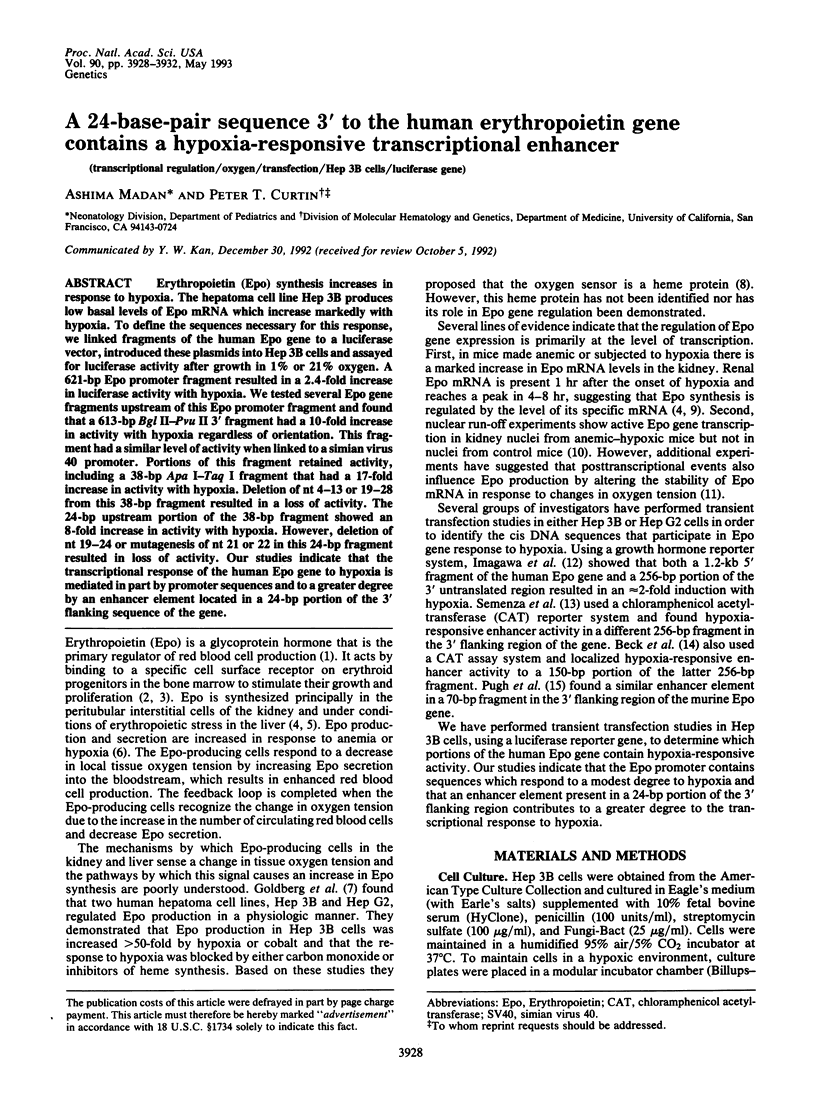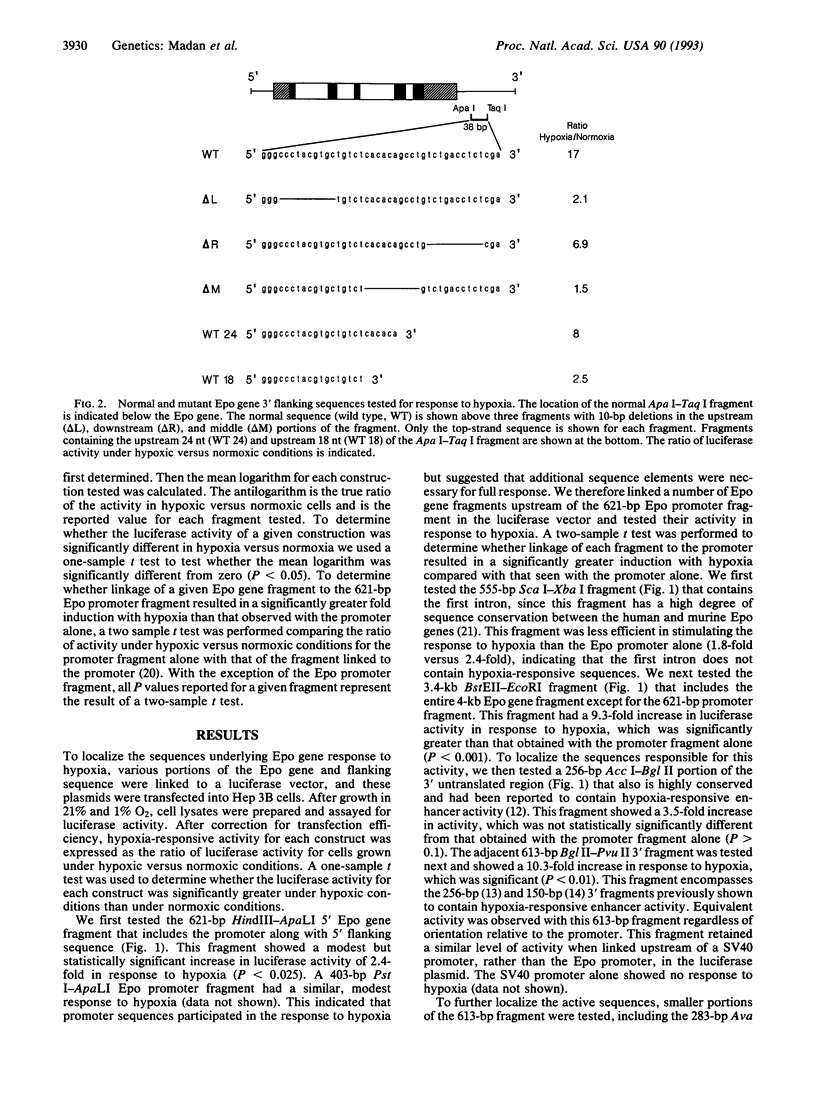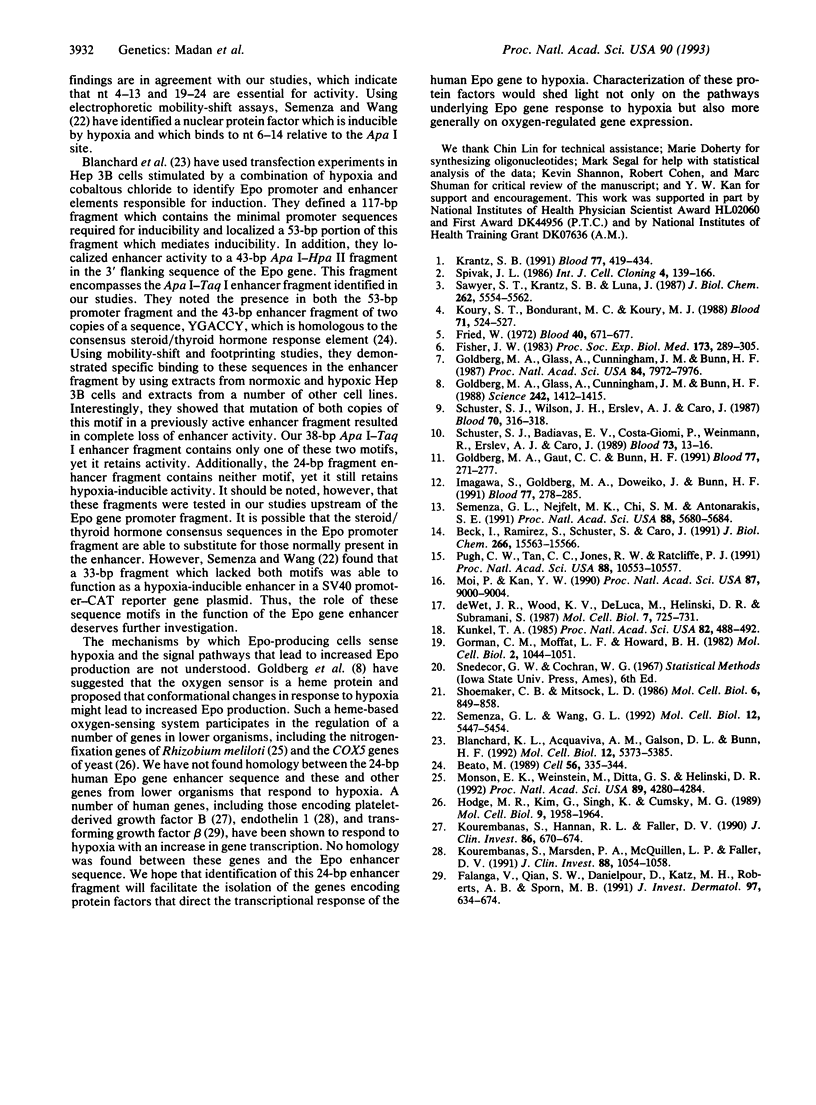Abstract
Erythropoietin (Epo) synthesis increases in response to hypoxia. The hepatoma cell line Hep 3B produces low basal levels of Epo mRNA which increase markedly with hypoxia. To define the sequences necessary for this response, we linked fragments of the human Epo gene to a luciferase vector, introduced these plasmids into Hep 3B cells and assayed for luciferase activity after growth in 1% or 21% oxygen. A 621-bp Epo promoter fragment resulted in a 2.4-fold increase in luciferase activity with hypoxia. We tested several Epo gene fragments upstream of this Epo promoter fragment and found that a 613-bp Bgl II-Pvu II 3' fragment had a 10-fold increase in activity with hypoxia regardless of orientation. This fragment had a similar level of activity when linked to a simian virus 40 promoter. Portions of this fragment retained activity, including a 38-bp Apa I-Taq I fragment that had a 17-fold increase in activity with hypoxia. Deletion of nt 4-13 or 19-28 from this 38-bp fragment resulted in a loss of activity. The 24-bp upstream portion of the 38-bp fragment showed an 8-fold increase in activity with hypoxia. However, deletion of nt 19-24 or mutagenesis of nt 21 or 22 in this 24-bp fragment resulted in loss of activity. Our studies indicate that the transcriptional response of the human Epo gene to hypoxia is mediated in part by promoter sequences and to a greater degree by an enhancer element located in a 24-bp portion of the 3' flanking sequence of the gene.
Full text
PDF




Selected References
These references are in PubMed. This may not be the complete list of references from this article.
- Beato M. Gene regulation by steroid hormones. Cell. 1989 Feb 10;56(3):335–344. doi: 10.1016/0092-8674(89)90237-7. [DOI] [PubMed] [Google Scholar]
- Beck I., Ramirez S., Weinmann R., Caro J. Enhancer element at the 3'-flanking region controls transcriptional response to hypoxia in the human erythropoietin gene. J Biol Chem. 1991 Aug 25;266(24):15563–15566. [PubMed] [Google Scholar]
- Blanchard K. L., Acquaviva A. M., Galson D. L., Bunn H. F. Hypoxic induction of the human erythropoietin gene: cooperation between the promoter and enhancer, each of which contains steroid receptor response elements. Mol Cell Biol. 1992 Dec;12(12):5373–5385. doi: 10.1128/mcb.12.12.5373. [DOI] [PMC free article] [PubMed] [Google Scholar]
- Falanga V., Qian S. W., Danielpour D., Katz M. H., Roberts A. B., Sporn M. B. Hypoxia upregulates the synthesis of TGF-beta 1 by human dermal fibroblasts. J Invest Dermatol. 1991 Oct;97(4):634–637. doi: 10.1111/1523-1747.ep12483126. [DOI] [PubMed] [Google Scholar]
- Fisher J. W. Control of erythropoietin production. Proc Soc Exp Biol Med. 1983 Jul;173(3):289–305. doi: 10.3181/00379727-173-41646. [DOI] [PubMed] [Google Scholar]
- Fried W. The liver as a source of extrarenal erythropoietin production. Blood. 1972 Nov;40(5):671–677. [PubMed] [Google Scholar]
- Goldberg M. A., Dunning S. P., Bunn H. F. Regulation of the erythropoietin gene: evidence that the oxygen sensor is a heme protein. Science. 1988 Dec 9;242(4884):1412–1415. doi: 10.1126/science.2849206. [DOI] [PubMed] [Google Scholar]
- Goldberg M. A., Gaut C. C., Bunn H. F. Erythropoietin mRNA levels are governed by both the rate of gene transcription and posttranscriptional events. Blood. 1991 Jan 15;77(2):271–277. [PubMed] [Google Scholar]
- Goldberg M. A., Glass G. A., Cunningham J. M., Bunn H. F. The regulated expression of erythropoietin by two human hepatoma cell lines. Proc Natl Acad Sci U S A. 1987 Nov;84(22):7972–7976. doi: 10.1073/pnas.84.22.7972. [DOI] [PMC free article] [PubMed] [Google Scholar]
- Gorman C. M., Moffat L. F., Howard B. H. Recombinant genomes which express chloramphenicol acetyltransferase in mammalian cells. Mol Cell Biol. 1982 Sep;2(9):1044–1051. doi: 10.1128/mcb.2.9.1044. [DOI] [PMC free article] [PubMed] [Google Scholar]
- Hodge M. R., Kim G., Singh K., Cumsky M. G. Inverse regulation of the yeast COX5 genes by oxygen and heme. Mol Cell Biol. 1989 May;9(5):1958–1964. doi: 10.1128/mcb.9.5.1958. [DOI] [PMC free article] [PubMed] [Google Scholar]
- Imagawa S., Goldberg M. A., Doweiko J., Bunn H. F. Regulatory elements of the erythropoietin gene. Blood. 1991 Jan 15;77(2):278–285. [PubMed] [Google Scholar]
- Kourembanas S., Hannan R. L., Faller D. V. Oxygen tension regulates the expression of the platelet-derived growth factor-B chain gene in human endothelial cells. J Clin Invest. 1990 Aug;86(2):670–674. doi: 10.1172/JCI114759. [DOI] [PMC free article] [PubMed] [Google Scholar]
- Kourembanas S., Marsden P. A., McQuillan L. P., Faller D. V. Hypoxia induces endothelin gene expression and secretion in cultured human endothelium. J Clin Invest. 1991 Sep;88(3):1054–1057. doi: 10.1172/JCI115367. [DOI] [PMC free article] [PubMed] [Google Scholar]
- Koury S. T., Bondurant M. C., Koury M. J. Localization of erythropoietin synthesizing cells in murine kidneys by in situ hybridization. Blood. 1988 Feb;71(2):524–527. [PubMed] [Google Scholar]
- Krantz S. B. Erythropoietin. Blood. 1991 Feb 1;77(3):419–434. [PubMed] [Google Scholar]
- Kunkel T. A. Rapid and efficient site-specific mutagenesis without phenotypic selection. Proc Natl Acad Sci U S A. 1985 Jan;82(2):488–492. doi: 10.1073/pnas.82.2.488. [DOI] [PMC free article] [PubMed] [Google Scholar]
- Moi P., Kan Y. W. Synergistic enhancement of globin gene expression by activator protein-1-like proteins. Proc Natl Acad Sci U S A. 1990 Nov;87(22):9000–9004. doi: 10.1073/pnas.87.22.9000. [DOI] [PMC free article] [PubMed] [Google Scholar]
- Monson E. K., Weinstein M., Ditta G. S., Helinski D. R. The FixL protein of Rhizobium meliloti can be separated into a heme-binding oxygen-sensing domain and a functional C-terminal kinase domain. Proc Natl Acad Sci U S A. 1992 May 15;89(10):4280–4284. doi: 10.1073/pnas.89.10.4280. [DOI] [PMC free article] [PubMed] [Google Scholar]
- Pugh C. W., Tan C. C., Jones R. W., Ratcliffe P. J. Functional analysis of an oxygen-regulated transcriptional enhancer lying 3' to the mouse erythropoietin gene. Proc Natl Acad Sci U S A. 1991 Dec 1;88(23):10553–10557. doi: 10.1073/pnas.88.23.10553. [DOI] [PMC free article] [PubMed] [Google Scholar]
- Sawyer S. T., Krantz S. B., Goldwasser E. Binding and receptor-mediated endocytosis of erythropoietin in Friend virus-infected erythroid cells. J Biol Chem. 1987 Apr 25;262(12):5554–5562. [PubMed] [Google Scholar]
- Schuster S. J., Badiavas E. V., Costa-Giomi P., Weinmann R., Erslev A. J., Caro J. Stimulation of erythropoietin gene transcription during hypoxia and cobalt exposure. Blood. 1989 Jan;73(1):13–16. [PubMed] [Google Scholar]
- Schuster S. J., Wilson J. H., Erslev A. J., Caro J. Physiologic regulation and tissue localization of renal erythropoietin messenger RNA. Blood. 1987 Jul;70(1):316–318. [PubMed] [Google Scholar]
- Semenza G. L., Nejfelt M. K., Chi S. M., Antonarakis S. E. Hypoxia-inducible nuclear factors bind to an enhancer element located 3' to the human erythropoietin gene. Proc Natl Acad Sci U S A. 1991 Jul 1;88(13):5680–5684. doi: 10.1073/pnas.88.13.5680. [DOI] [PMC free article] [PubMed] [Google Scholar]
- Semenza G. L., Wang G. L. A nuclear factor induced by hypoxia via de novo protein synthesis binds to the human erythropoietin gene enhancer at a site required for transcriptional activation. Mol Cell Biol. 1992 Dec;12(12):5447–5454. doi: 10.1128/mcb.12.12.5447. [DOI] [PMC free article] [PubMed] [Google Scholar]
- Shoemaker C. B., Mitsock L. D. Murine erythropoietin gene: cloning, expression, and human gene homology. Mol Cell Biol. 1986 Mar;6(3):849–858. doi: 10.1128/mcb.6.3.849. [DOI] [PMC free article] [PubMed] [Google Scholar]
- Spivak J. L. The mechanism of action of erythropoietin. Int J Cell Cloning. 1986 May;4(3):139–166. doi: 10.1002/stem.5530040302. [DOI] [PubMed] [Google Scholar]
- de Wet J. R., Wood K. V., DeLuca M., Helinski D. R., Subramani S. Firefly luciferase gene: structure and expression in mammalian cells. Mol Cell Biol. 1987 Feb;7(2):725–737. doi: 10.1128/mcb.7.2.725. [DOI] [PMC free article] [PubMed] [Google Scholar]


